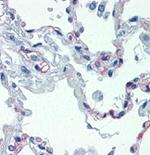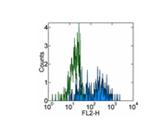Search Thermo Fisher Scientific
Invitrogen
CD93 (AA4.1) Monoclonal Antibody (R139), eBioscience™
FIGURE: 1 / 2
CD93 (AA4.1) Antibody (14-0939-82) in Flow


Product Details
14-0939-82
Species Reactivity
Published species
Host/Isotype
Class
Type
Clone
Conjugate
Form
Concentration
Purification
Storage buffer
Contains
Storage conditions
Shipping conditions
RRID
Product Specific Information
Description: The monoclonal antibody R139 recognizes human CD93, also known as C1qRp. The glycoprotein CD93 binds to C1q, the subunit of the complement protein, mannose binding lectin and pulmonary surfactant protein A. CD93 is predicted to play a role in the clearance of apoptotic cells. Expression of CD93 is confined to myeloid cells with higher expression on monocytes than neutrophils, eosinophils, platelets and endothelial cells. Expression on DC's is downregulated upon maturation. Additionally, CD93 has been shown to define an early bone marrow stem cell population of hematopoietic and hepatic precursors.
The monoclonal antibody R139 blocks C1q-mediated enhancement of phagocytosis.
CD93 can be shed from the cell surface. This phenomenon can be measured using R3 antibody as detection with R139 as capture to detect soluble CD93 by ELISA. The epitope for R139 resides in the EGF domains.
Applications Reported: This R139 antibody has been reported for use in flow cytometric analysis, immunoprecipitation, immunoblotting (WB) under nonreducing conditions, ELISA, and immunohistochemistry of formalin-fixed paraffin embedded tissue.
Applications Tested: This R139 antibody has been tested by flow cytometric analysis of human peripheral blood cells. This can be used at less than or equal to 0.5 µg per test. A test is defined as the amount (µg) of antibody that will stain a cell sample in a final volume of 100 µL. Cell number should be determined empirically but can range from 10^5 to 10^8 cells/test. The R139 antibody has been tested by immunohistochemistry of formalin-fixed paraffin embedded human tissue using low pH antigen retrieval and can be used at less than or equal to 40 µg/mL. It is recommended that the antibody be carefully titrated for optimal performance in the assay of interest.
Purity: Greater than 90%, as determined by SDS-PAGE.
Aggregation: Less than 10%, as determined by HPLC.
Filtration: 0.2 µm post-manufacturing filtered.
Target Information
The protein encoded by this gene is a cell-surface glycoprotein and type I membrane protein that was originally identified as a myeloid cell-specific marker. The encoded protein was once thought to be a receptor for C1q, but now is thought to instead be involved in intercellular adhesion and in the clearance of apoptotic cells. The intracellular cytoplasmic tail of this protein has been found to interact with moesin, a protein known to play a role in linking transmembrane proteins to the cytoskeleton and in the remodelling of the cytoskeleton.
For Research Use Only. Not for use in diagnostic procedures. Not for resale without express authorization.
Bioinformatics
Protein Aliases: C1q receptor; C1q receptor 1; C1q/MBL/SPA receptor; C1qR; CD93; CD93 antigen; CDw93; Complement component 1 q subcomponent receptor 1; complement component 1, q subcomponent, receptor 1; Complement component C1q receptor; Matrix-remodeling-associated protein 4; matrix-remodelling associated 4
Gene Aliases: C1qR(P); C1QR1; C1qRP; CD93; CDw93; dJ737E23.1; ECSM3; MXRA4
UniProt ID: (Human) Q9NPY3
Entrez Gene ID: (Human) 22918

Performance Guarantee
If an Invitrogen™ antibody doesn't perform as described on our website or datasheet,we'll replace the product at no cost to you, or provide you with a credit for a future purchase.*
Learn more
We're here to help
Get expert recommendations for common problems or connect directly with an on staff expert for technical assistance related to applications, equipment and general product use.
Contact tech support
